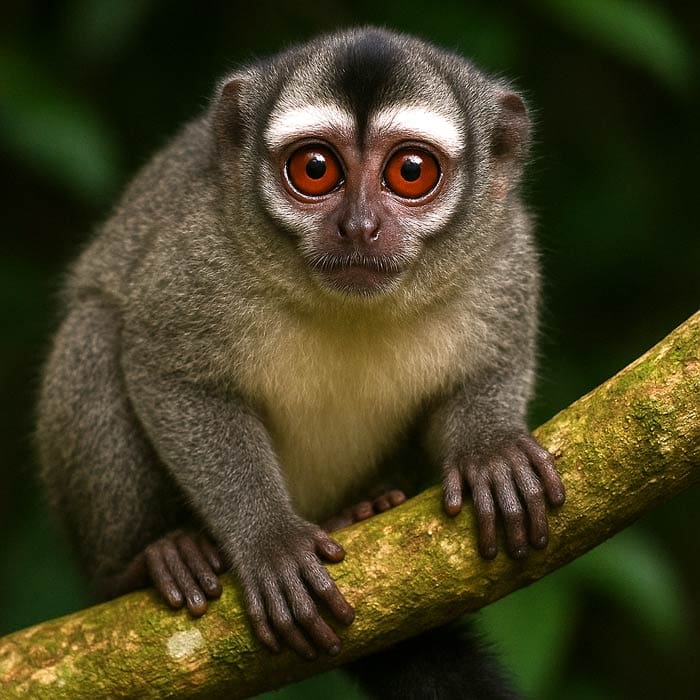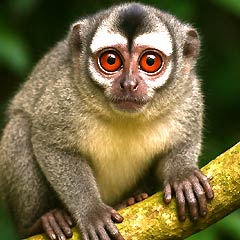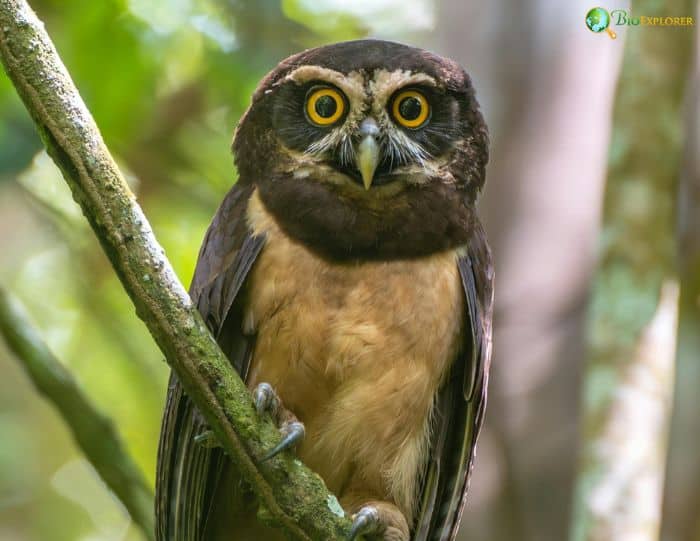
| Animalia | Primates | Aotidae | Aotus | Aotus lemurinus |


- Common Name: Gray-bellied night monkey.
- Family: Aotidae
- Fur Color(s): Gray, White/Peach.
- Body Dimensions: Approximately 1 kilogram in weight.
- Habitat: Primary and secondary highland and mid-altitude forests, particularly cloud forests.
- Diet: Fruits, Insects, nectar, small amounts of leaves.
- Countries: Colombia and Ecuador.
- Taxonomist: Isidore Geoffroy Saint-Hilaire.
- Year of Classification: 1843.
The gray-bellied night monkey (Aotus lemurinus) is a nocturnal primate belonging to the Aotus genus, commonly known as the owl monkey. Native to parts of Colombia and Ecuador, this primate is distinguished by its gray belly, dense woolly fur, and notably large red eyes surrounded by white or cream-colored fur.
Primarily arboreal, the Gray-bellied night monkey has adapted to life in dense forest canopies. Its nocturnal habits, a unique trait among New World Monkeys, allow it to avoid daytime predators and compete less for food.
Table of Contents
Gray-bellied Night Monkey Distribution
Gray-bellied Night Monkey Characteristics
The Gray-bellied night monkey exhibits distinct physical characteristics tailored to its nocturnal lifestyle.
- This species has dense, woolly fur that is predominantly grayish on the abdomen, contrasting sharply with the darker dorsal fur.
- Their small head features prominently large, forward-facing red eyes encircled by light-colored fur. This adaptation enhances their nocturnal vision.
- Unlike diurnal primates, this species lacks a tapetum lucidumWhat is tapetum lucidum?The tapetum lucidum is a reflective layer behind the retina that enhances night vision by bouncing light back through the photoreceptors.; however, its large eyes compensate by maximizing the use of available low light.
- They have relatively short, rounded ears hidden by dense fur.
- Their tail, which is bushy and non-prehensile, aids balance during arboreal navigation. Limbs are relatively short but strong, providing excellent maneuverability among branches.
Adults typically weigh around 1 kilogram and exhibit no sexual dimorphism in size or coloration. This monkey is primarily quadrupedal, adeptly moving through the canopy on all fours. Their specialized visual acuity, combined with agile locomotion, allows them to successfully forage at night, avoiding competition with diurnal species.
Habitat

The gray-bellied night monkey is found predominantly in primary and secondary forests in the highland and mid-altitude regions of Colombia and Ecuador.
- These monkeys prefer dense, contiguous forest canopies, which provide essential cover for nocturnal activities and protection from predators.
- The species has adapted to mountainous terrains, typically residing in cloud forests and premontane forests characterized by high humidity and consistent temperatures.
Recent ecological modeling suggests that climate change poses a significant threat to these habitats, with projected habitat shrinkage particularly notable in Ecuador.
- Fragmentation due to anthropogenic land conversionWhat is anthropogenic land conversion?Anthropogenic land conversion refers to the transformation of natural landscapes into urban, agricultural, or industrial areas due to human activities. further exacerbates habitat loss, reducing viable areas for this primate.
- Stable and intact habitats are crucial as these monkeys rely heavily on dense canopy coverage for food sources, protection, and nesting sites.
- Conservation efforts thus emphasize the restoration and protection of highland forests, as maintaining habitat stability will be essential in preserving this species under future climate scenarios.
What Do Gray-bellied Night Monkeys Eat?

The diet of the Gray-bellied night monkey is predominantly frugivorous, primarily consisting of fruits from a variety of forest trees.
- They supplement this diet with insects, nectar, and small amounts of leaves, thus categorizing them as omnivorous primates.
- Compared to other types of monkeys, their nocturnal activity pattern is particularly distinctive, aligning with peak availability periods of certain fruits and insects.
- Fruits provide essential sugars and nutrients, while insects offer protein and fats critical for their overall nutrition.
The Gray-bellied night monkey is known to forage actively during the night, using its keen eyesight and agile movements to locate food efficiently in low-light conditions. The variability in their diet, although primarily fruit-based, highlights their adaptability and resilience to minor changes in food availability; however, significant habitat disturbances could disrupt their nutritional balance.
What Eats Gray-bellied Night Monkeys?

Predators of the Gray-bellied night monkey mainly include nocturnal and crepuscular animals adapted to hunting at night.
- Common predators include birds of prey, such as many types of owls (e.g., crested owl, spectacled owl), which rely heavily on their excellent night vision to locate and capture prey.
- Arboreal predators, such as large snakes, also pose significant threats, ambushing the monkeys as they move through the branches.
- Occasionally, terrestrial predators such as wild cats, if able to climb into lower forest canopies, may also prey upon these monkeys.
Their primary defense mechanisms include cryptic coloration, nocturnal activity that reduces visibility to daytime predators, and arboreal agility, which allows for rapid evasion among tree branches. Human activities such as hunting and illegal wildlife trafficking represent substantial threats.
Ecological Importance

The Gray-bellied night monkey plays an important ecological role in its habitat.
- As a frugivore, it plays a significant role in seed dispersal, thereby aiding in forest regeneration and maintaining plant diversity.
- Additionally, their insectivorous diet helps control insect populations, thereby indirectly affecting plant health and ecosystem stability.
- As prey species, they also contribute to the dynamics of the food web within their habitat, supporting predator populations.
Maintaining healthy populations of gray-bellied night monkeys thus ensures ecological balance and biodiversity in highland forest ecosystems. The decline of this species could disrupt these critical ecological services, underscoring the importance of targeted conservation efforts aimed at preserving stable and resilient populations in the face of environmental changes and human disturbances.
Gray-bellied Night Monkey Fun Facts
- It is one of the few nocturnal monkey species in the Americas, uniquely adapted to life in low-light environments where fewer predators and competitors are active.
- This monkey exhibits no sexual dimorphism, meaning males and females look very similar in size and coloration, making gender identification challenging without closer inspection.
- Their large red eyes are adapted for enhanced night vision, enabling efficient navigation and foraging in the dark forest canopies.
- The gray-bellied night monkey is also known for its dense, woolly fur, which provides excellent camouflage against predators and crucial insulation in cooler, high-altitude habitats.
The gray-bellied night monkey is a unique primate, perfectly adapted to its nocturnal, arboreal lifestyle.
Protecting this vulnerable species requires concerted conservation strategies aimed at preserving their natural habitats, mitigating climate-induced habitat shifts, and reducing human-driven threats. Continued research into their ecological roles, habitat requirements, and species-specific responses to environmental changes will be crucial for understanding these organisms.
![]()











